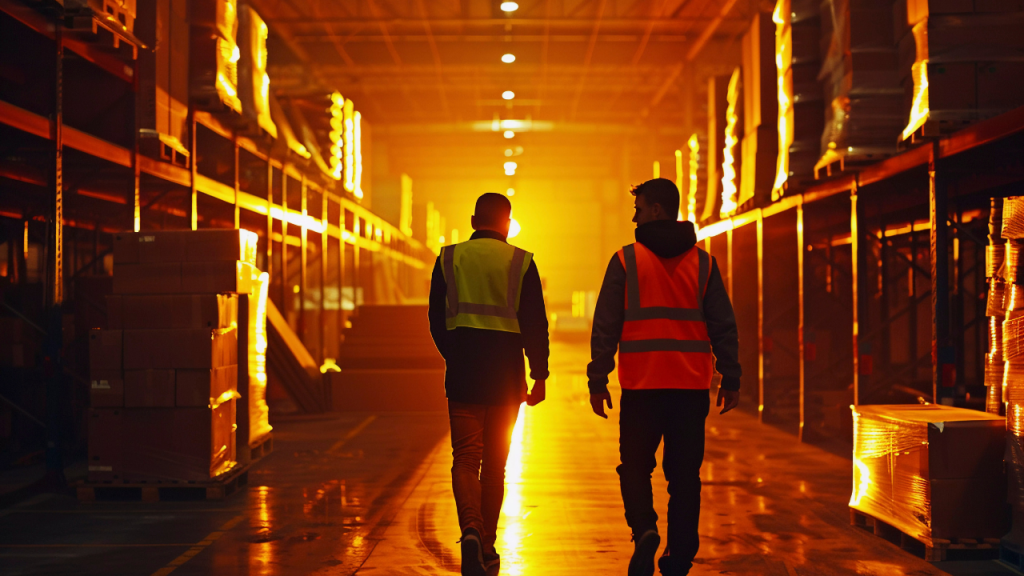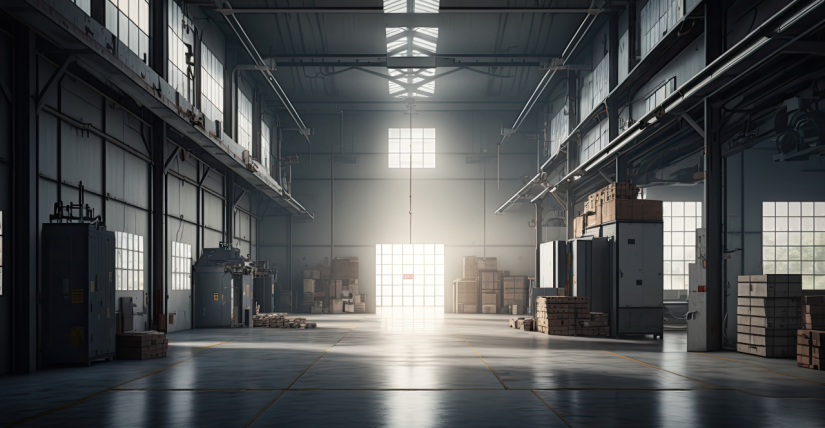Whereas in warehouse operations, discussion usually focuses on high-value performance metrics—shipping time, order filler rate, picking accuracy, inventory visibility, automation integration level, and shipping schedules.
Premium robotics, warehouse management software (WMS), and real-time tracking technology take center stage. And surprisingly, one of the most critical elements of the entire logistics chain is never on the table: the first 100 feet inside the warehouse, just beyond the dock door.
It’s not a lot. No special machinery. No strip of blinking lights projecting data. Just a hunk of concrete where product comes off the truck and sits in wait to sort, move, or stored.
But this modest space has out of proportion sway on whether or not the warehouse operates smoothly. Neglecting it causes delays, safety issues, and worker inefficiencies that carry across the facility.
Why The First 100 Feet Is Overlooked?
The first 100 feet inside the dock door is often managed as a transition zone—a compromise space where responsibility hands off from the transportation team to the warehousing team.
Because it’s a handoff zone, it is usually cobble together with minimal planning. Most operations have this space full of stagnant carts, jammed aisles, blocked staging areas, and sloppy piles of incoming inventory.
It doesn’t have the feel of a space that would optimize because it doesn’t “do” something showy in the first place. There isn’t any picking system, any product sorting, or any tunnel scanning.
And yet, this space is the first domino in a chain of steps that’s really, really long. If that domino wobbles just a little bit, everything after that is just a little bit harder, a little bit slower, and a little more infuriating.
The Sneaky Effect Of A Shitty Transition Zone
Why this area is so crucial is due to the characteristics of disruptions. They don’t become these huge problems right off the bat. Instead, inefficiency here bleeds over into all else afterward:
- Congestion at docks: Trunks take longer to offload if offloading is slow or uncoordinated. That builds up outside and delays incoming freight.
- Staging chaos: A disorganized receiving area causes chaos and misplaced products, so that it is hard for teams to locate things or start the putaway process effectively.
- Inaccurate staffing: The personnel will be under-staffed, not because they are, but because the workflow is blocked from the beginning.
- Operational drag: A few minutes of lag on each shipment here adds up to hours of waste per week, and days over the space of a month.
What’s Actually Happening?
The zone just doesn’t bounce back from disturbance-adverse weather, illness, or spiking volume. And because supply chains rise and fall on the strength of being able to absorb the unexpected, that lack of resilience silently eats away at performance.
What’s Making This Zone So Challenging?
A few complicating factors make the first 100 feet particularly vulnerable:
1. Fuzziness Of Responsibility
Who is responsible for this space? The dock manager? The floor leads in the warehouse? The inbound logistics coordinator? Oftentimes, nobody knows. And that lack of ownership results in a patchwork design instead of careful thought.
2. Insufficient Tech Investment
Technology investments in the warehouse typically focus on order picking, sorting, and packaging—all customer-facing, measurable activities. The receiving area, out of customers’ view and often located behind dashboards, is left behind.
3. Ergonomic Issues
Manual work dominates in this land—bending, lifting, carrying, pushing. Each time the machinery or layout isn’t appropriately designed, employees end up exhausting themselves sooner, creating more errors, and injuring themselves. That’s a translation into lost time and extra cost.
4. No Real-Time Visibility
Because there is no real-time monitoring or dock scheduling software on the job, surprises are a shock. A behind-schedule arrival truck, an unexpected bulk shipment, or a misassigned trailer can convert the room into a traffic jam.

How To Fix the First 100 Feet: Practical, Cost-Effective Strategies?
Fortunately, retooling this lump of idle concrete into a productivity booster doesn’t require an expense or months of preparation. What it requires is mindful design, enhanced coordination, and fundamental tech tools.
1. Treat It As A Core Operational Area
Mindset shift number one is required: this isn’t a pass-through, it’s part of your process. Labelling it with the same dignity as choosing zones or pack lines understandably leads to improvements.
Create a floor plan that reduces travel distance, eliminates redundant motion, and gives open pathways for people and materials.
2. Invest In Smart Equipment
A few strategic equipment investments can reap gigantic dividends
- Gravity conveyors: Get boxes rolling from trailer to staging without lifting them.
- Telescopic belt conveyors: Reduce labor going into trailers, speeding up and streamlining unloading.
- Mobile staging carts: Allow presorting by SKU or destination without loss of flexibility.
These options don’t require big automation budgets-they’re high-impact, low-tech solutions that make flow much easier.
3. Improve Communication Among Teams
Poor communication among warehouse personnel, transport managers, and drivers is a source of delays. Dock scheduling software can significantly cut down on miscommunications.
Since there is real-time visibility, staging teams are made aware of:
- What truck arrives when
- What it carries
- What is its priority level
- Which dock door to assign
This visibility enables teams to pre-stage staging areas, assign the right amount of labor, and avoid surprises.
4. Design For Flexibility
Get ready for disruption. Design the space with flexibility in mind:
- Modular racking that you can relocate when volumes spike
- Cross-functional staff training, so each time-out doesn’t strand stock
- Overflow areas that temporarily store excess merchandise without jamming inner passageways
The goal isn’t perfection—it’s resilience. You want this space to be able to soak up shock without shutting down the flow.
5. Ergonify It
Reducing employee stress reduces fatigue and increases throughput. Restrict heavy lifting. Position unloading surfaces at waist level.
Provide equipment such as pallet jacks, tuggers, or lifts that match the work being performed.
And don’t underestimate lighting—poor visibility equals mistakes and delays. Lighted, well-lighted spaces are safer and more productive to work in.
Case In Point: Real Gains From A Reimagined Dock Zone
One of the big-box retailers revamped its initial 100 feet with roller conveyors and reversed the staging pattern from a “stack and sort” operation to a lane-by-product configuration. The dividends were rapid:
- Unloading times fell 22%
- Worker strain complaints fell 40%
- Dock-to-stock took more than 30 minutes per truckload
All this for one robot, sensor, or enormous capital expenditure. Just more space utilization and improved coordination.
Why The First 100 Feet Is More Important Than Ever?
With logistics getting more complex—shorter delivery windows, additional SKUs, narrower labor pools—the margin for error is never thinner.
Warehouses are being asked to do more with less. Under that kind of weather, to overlook any segment of the flow—even a “boring” segment like the first 100 feet—is a mistake.
This is where the tone is established for the entire shift. Begin here in disorientation or backlog, and all the rest of the day rushes to catch up. Begin here in smoothness and flow, and all downstream flows more smoothly.
Start Strong, Stay Smooth
Redesign the front 100 feet. Don’t think of it as an afterthought, but as a starting point for everything that comes next.
Construct it to operate with intent. Design it to enable your people. Make it align with the rest of your operation.
And don’t skimp on it just because it doesn’t sparkle. This small segment of concrete is the break-or-make of your warehouse productivity. Be gentle with it, and it will pay you back in speed, safety, and sanity.
Read Also:




Leave A Comment